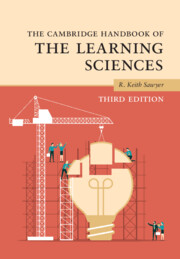Book contents
- The Cambridge Handbook of the Learning Sciences
- The Cambridge Handbook of the Learning Sciences
- Copyright page
- Contents
- Figures
- Tables
- Contributors
- Preface
- 1 An Introduction to the Learning Sciences
- Part I Foundations
- 2 Foundations of the Learning Sciences
- 3 Scaffolding
- 4 Project-Based Learning
- 5 Metacognition and Self-Regulated Learning
- 6 A History of Conceptual Change Research
- 7 Learning in Activity
- 8 Cognitive Apprenticeship
- Part II Methodologies
- Part III Grounding Technology in the Learning Sciences
- Part IV Learning Together
- Part V Learning Disciplinary Knowledge
- Part VI Moving Learning Sciences Research into the Classroom
- Index
- References
8 - Cognitive Apprenticeship
from Part I - Foundations
Published online by Cambridge University Press: 14 March 2022
- The Cambridge Handbook of the Learning Sciences
- The Cambridge Handbook of the Learning Sciences
- Copyright page
- Contents
- Figures
- Tables
- Contributors
- Preface
- 1 An Introduction to the Learning Sciences
- Part I Foundations
- 2 Foundations of the Learning Sciences
- 3 Scaffolding
- 4 Project-Based Learning
- 5 Metacognition and Self-Regulated Learning
- 6 A History of Conceptual Change Research
- 7 Learning in Activity
- 8 Cognitive Apprenticeship
- Part II Methodologies
- Part III Grounding Technology in the Learning Sciences
- Part IV Learning Together
- Part V Learning Disciplinary Knowledge
- Part VI Moving Learning Sciences Research into the Classroom
- Index
- References
Summary
This chapter reviews how people learn during apprenticeships, ways of guiding beginners while they engage in authentic situated activity with more experienced people. Apprenticeship practices are found throughout the world both in cultures with formal schooling and in those without. Traditional apprenticeship practices tend to focus on physical and visible activities, but most schooling is directed toward conceptual learning outcomes which are usually not physical and visible – like formulas in mathematics or theories in physics. This chapter extends apprenticeship research to cognitive apprenticeship, and describes apprenticeships that are designed to lead to abstract or conceptual knowledge. These involve scaffolding, metacognitive reflection, problem-based learning, and situated social practices. Effective apprenticeship often involves productive failure, when learners initially develop potential solutions that are wrong but that can be productively guided toward conceptually correct answers.
Keywords
- Type
- Chapter
- Information
- The Cambridge Handbook of the Learning Sciences , pp. 156 - 174Publisher: Cambridge University PressPrint publication year: 2022
References
- 1
- Cited by

